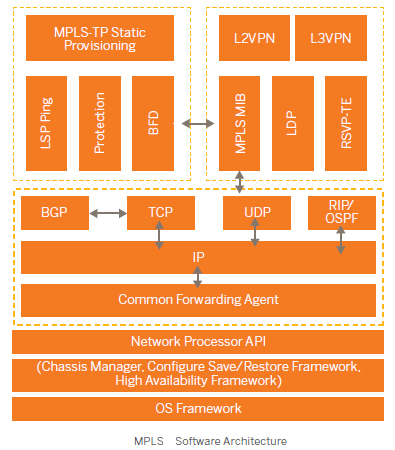Multiprotocol Label Switching (MPLS)
One solution for many protocols. Multiprotocol Label Switching (MPLS) is the key transport technology for both current and future packet and optical networks. Sysmetlab is a leading provider of MPLS software suites, including software protocols for MPLS, MPLS-TP and GMPLS control planes used to build MPLS-enabled networking equipment for core networks, mobile backhaul networks and data center overlay networks. Sysmetlab’s MPLS software suite, along with Sysmetlab’s Intelligent Switching Solution (ISS), allows network equipment manufacturers (NEMs) to accelerate development of feature-rich, easily manageable, scalable and resilient network equipment.
MPLS Implementation
Sysmetlab MPLS implementation is an efficient and portable implementation of the label-switching capability mechanism. It supports Layer 2 VPN, Layer 3 VPN and GMPLS extensions for packet-switched networks, and enables migration of existing IPv4 networks to IPv6, leveraging the VPN Provider Edge (6VPE) approach feature.
MPLS-TP Implementation
Sysmetlab MPLS-TP implementation is a portable implementation of the MPLS-Transport Profile, providing path protection switching, QoS and OAM capabilities to enable end-product traffic engineering, fault management and faster switching capabilities.

Key Features
- Configurable as LER/PE or LSR
- Manageable through SNMP and CLI
- Includes software forwarding module
- Generic API support for hardware-based MPLS Forwarding Module implementation
- Highly portable code with flexible buffer and timer management libraries
- Pre-integrated with Sysmetlab’s IP and SNMP solutions
Generic Signaling Features
- Conservative Label Retention mode
- RSVP-TE and CR-LSP tunnel modifications
- Ethernet and ATM interface
- Multiple FEC classifications based on:
- IP Address Prefix
- Host Address
RSVP-TE Features
- Traffic Engineering (TE) tunnels
- Downstream on Demand label distribution mode
- LSP Pre-emption (setup and holding)
- Resource Class Affinity Attribute handling
- Loop detection using RRO
- Hello message extensions for rapid detection of node failures
- RSVP Refresh Overhead Reduction and Reliable Message Delivery
- DiffServ-aware E-LSP and L-LSP signaling
LDP/CR-LDP Features
- Basic and Extended Discovery mechanisms
- Downstream on Demand Label Distribution mode
- Ordered and Independent control
- Loop detection using path vectors and hop counts
- Penultimate Hop Popping (PHP)
- Stacked LSPs
LDP Features
- Downstream Unsolicited label distribution mode
- Liberal Label Retention mode
- VC/VP Merge capability
CR-LDP Features
- Constraint-based routed LSP (CR-LSP)
- DiffServ-aware E-LSP and L-LSP signaling
- LSP Preemption (Setup and Holding)
L2-VPN Features
- Control Plane support for Virtual Private Wired Services (VPWS)
- Pseudowire management and maintenance
- Control plane Layer 2 service support for Ethernet including VLAN
- Control plane support for collecting and maintaining PW-VC informational statistics